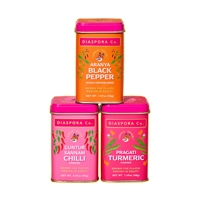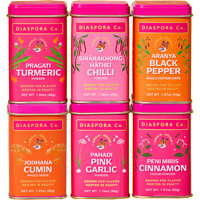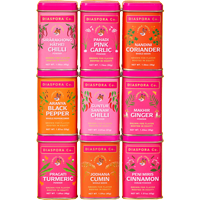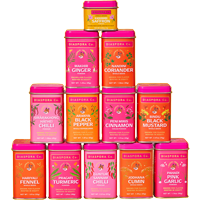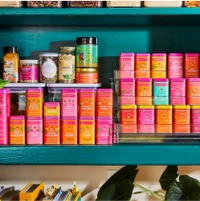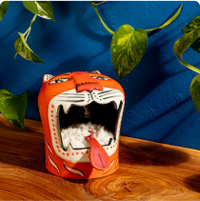My mother-in-law, a native of the North Indian state of Punjab, is a pragmatic cook. In her purely functional kitchen, there’s no romance or rumination around cooking. She cooks with instinctive ease, honed by years of experience and a mechanical acceptance of tradition. However, there are a few culinary rituals she holds dear. She makes her own ghee and grinds her own garam masala — the saporous blend of warm, aromatic spices often hailed as the definitive Indian spice mix, especially in Western discourse.
She roasts the spices — citrusy coriander, earthy cumin, minty green cardamom, smoky black cardamom, sweet cinnamon, piney cloves, floral peppercorns, fruity mace, and grassy kasoori methi (or dried fenugreek leaves).
She adds them one by one to her cast-iron kadhai in a meticulously-timed sequence, keeping in mind exactly how long each spice takes to roast, and constantly stirring and tossing the spices to evenly distribute the heat and prevent them from burning. She insists the proportions are based on andaz, or an intuitive, eyeball estimate that many experienced home cooks in the subcontinent rely on. The idea is to strike the right balance between the diverse flavour notes, in which lies the key to a good garam masala. Once the spices are toasty and exude a heady aroma, they are allowed to cool down before being ground into a slightly coarse, dark brown powder and stored in an airtight glass jar.
A piquant and perfectly balanced concoction of earthy, woody, sweet, and nutty notes, offset by a hint of piperine-laced pungency and a mild smokiness, this garam masala is her kitchen’s signature flavour. She depends on its khushboo or aroma to elevate just about any dish. Used sparingly, it adds a touch of opulence to simple dals, nudges out the umami notes in her allium-rich curries, and packs a punch to stir-fries and the spicy stuffing for her kulchas and parathas. Combined with a hand-pounded mix of lightly roasted ajwain (or carom seeds) and kasoori methi, it gives her chhole — a quintessential Punjabi dish of curried chickpeas — a zesty depth of flavour.
Nowadays, I tend to gravitate towards her garam masala to add a little to my marinades and rubs for tikkas and kebabs, roasts and grills. In more adventurous moments, I have sprinkled it on fries and added it to dips, sauces, and dressings. My most successful experiment was when I added it to a rendition of classic British coronation chicken, combined with homemade gur aam (a sweet and tangy chutney made with raw mangoes and jaggery, and flavoured with cardamom) and mayonnaise. Of course, I took my cue from chefs around the world. From Daniel Boulud to Bobby Flay, many well-known chefs have used garam masala to give everything from compound butters and silken sauces to honey-glazed pork ribs a spicy, desi update.
On the other hand, quite a few adopted food items with foreign roots get their Indian flair from garam masala spices. A classic example is the Allahabadi Christmas cake, named after the city of its origin in Uttar Pradesh, once a stronghold of the country’s Anglo-Indian community. The rich fruit cake, crammed with candied ash gourd and locally made marmalade, gets its Indianness from fragrant ghee and a mix of garam masala spices — cinnamon, cardamom, nutmeg and fennel — with dominant sweet notes. Anglo-Indian dishes such as croquettes, rissoles, and even sausages, often include garam masala, which gives these Western classics their desi flavour.
I, however, grew up on a garam masala of a different kind. In Bengal, where I belong, garam masala (pronounced gawrom mawshla) ordinarily means a minimalist mix of cardamom, cinnamon, and cloves. These spices are often added gota (or whole), along with bay leaves, as phoron or tempering. Alternatively, the spices are freshly ground into guro (powder), or bata (a wet paste), and added to specific dishes, typically towards the end, along with a dollop of ghee. An intense amalgamation of woody, sweet and pungent notes, it can make or break a dish. Prudence is key. In her cookbook Rannar Boi, Shulekha Sarkar recommends adding gawrom moshla only after taking a dish off the flame. Adding it earlier on would turn the dish bitter, she warns.
“Garam masala is a fluid term,” chef and author Sadaf Hussain told me. “The different spice blends that go into nihari (slow-cooked meat stew), biryanis, kababs, or even the chai masala are all essentially versions of garam masala in different permutations and combinations.”
In my home, as in many others, this gawrom mawshla is what lends definition to Bengali-style mutton and fish curries. It also adds fragrant robustness to vegetarian dishes like mochar ghonto (a dry curry made with banana blossoms), or dalnas — curries made with potatoes and seasonal vegetables like pointed gourd or cauliflower, or diamond-shaped lentil cakes called dhoka.
A more elaborate garam masala blend featuring stronger, more expensive aromatics like nutmeg, mace, and black cumin is reserved for plusher, more festive dishes and often packaged by commercial spice brands as shahi (royal) gawrom moshla. However, elders would often warn against excessive consumption of garam-masala laden food in Bengal’s tropical heat. “Shorir gawrom korbe,” they would say — it will heat up the body.
![]()
The term garam masala, as Maragaret Shaida writes in her book The Legendary Cuisine of Persia, “is derived from the Persian garm meaning hot and masaleh meaning ingredients or materials.” However, hot in this case does not merely indicate peppery heat. Instead, it refers to the intrinsic heating property of the spices that are typically used to make garam masala, such as black pepper, cardamom, cloves, cinnamon, nutmeg, mace etc.
Ancient medicinal systems like Ayurveda and Traditional Chinese Medicine identify ingredients by their elemental properties. Ayurvedic principles, for instance, classify substances into two broad categories according to their virya or potency into ushna or hot and sheetal or cold. This, in turn, affects the body’s energies, metabolism and digestion.
In the Perso-Arabic Unani system of medicine, the potency or active principle of ingredients is known as taseer. Garam masala principally refers to spices that have a warming effect on the body. By inference, it also refers to a blend of such spices, whether ground or whole. Many, in fact, ascribe garam masala’s popularity in the cuisines of northern India to its heating properties, deemed suitable for the harsh north Indian winters.
These spices are also strong aromatics, an attribute that is crucial to their culinary role, especially in spice blends like garam masala, which is primarily added as a strong, fragrant finish to dishes. Popular garam masala components such as cardamoms, cinnamon, cloves, tailed pepper (or allspice), in addition to other spices like fenugreek seeds, saffron, etc are mentioned in the millenia-old Ayurvedic text Charaka Samhita, under the group of aromatic drugs called Sarvagandha.
In the cuisine of Lucknow, the erstwhile city of the Nawabs, known for its refinement and a spice philosophy informed by consultations with hakims (or practitioners of Unani medicine), garam masala blends may also include other fragrant ingredients like paan ki jad (or betel root), khus ki jad (vetiver root), and jarakush (lemon grass), which not only heighten aroma and flavour but also aid in digestion.
![]()
Narratives around the origin of garam masala as a composite spice blend are amorphous. Food historians and culinary writers have often drawn parallels between the Persian spice blend advieh and Indian garam masala. In her book Nightingales and Roses, Iranian journalist and cookbook author Maryam Sinaiee suggests that the Iranian advieh was an import from India. “During the sixteenth and seventeenth centuries, the Mughal rulers of India were highly influenced by Persian culture, and often had Persian chefs at their courts. These chefs most likely introduced garam masala to Iran when they returned home,” writes Sinaiee.
Elaborate and complex spice mixes have long been considered the hallmark of Mughal cuisine. “A practice noted as distinctive because it was not common in other Indian cooking in the Mughal era,” writes Charmaine O’Brien in The Penguin Food Guide to India. She points out how many of these spices travelled a long distance to reach the Mughal kitchen.
Food writer and author Marryam H. Reshii reminds me that of the common garam masala spices, only pepper and cardamom are native to India. “Cinnamon came from Sri Lanka; nutmeg, cloves, and mace from a small group of volcanic islands in Eastern Indonesia (the Maluku islands, also referred to Spice Islands); and black cardamom from the Eastern Himalayas; and sources of origin often kept secret by the traders,” says Reshii.
In her book, O’Brien argues that while exorbitantly priced and traded spices were highly desirable in royal meals, regular Indian kitchens were typically restricted to inexpensive, locally grown spices. “The now ubiquitous garam masala of cumin, cinnamon, cardamom, cloves, and black pepper is typical of the spice mixes developed for the Mughal,” O’Brien writes.
But the art of combining different spices to create new flavours antedated the arrival of the Mughals in India. For instance, the Ni’matnama, a quirky book of mostly obscure recipes compiled by Ghiyath Shah, the Sultan of Malwa, and his son Nasir Shah between 1495 and 1505, over two decades before Babur laid the foundation of the great Mughal empire, mentions dishes that use complex and elaborate spice blends evocative of garam masala. Texts composed earlier still, in the 11th and 12th centuries, also mention spice mixes that could easily qualify as ancient predecessors of garam masala.
However, it is reasonable to assume that the culinary use of expensive, traded spices was originally restricted to the affluent kitchens of royalty and aristocracy. As spices became more accessible and affordable, they slowly came to be incorporated into different cuisines. Over time, garam masala may have acquired its more egalitarian status. “But most of these spices like cardamom, nutmeg, and mace are expensive even by present-day standards,” says Vernika Awal, who documents her native food from Punjab on Instagram under the handle Delectable Reveries. “So, the use of garam masala in common domestic kitchens is still slightly marginal. The composition of the blend and its use in one’s kitchen may, in fact, reflect one’s economic status,” she adds.
![]()
Even within the narrow definition of a specific spice blend used largely in northern and western Indian cooking, garam masala is somewhat elusive. In her 1961 cookbook Mrs. Balbir Singh’s Indian Cookery, Singh (who has been dubbed the Indian Julia Child), describes garam masala in strict terms as “a mixture of cinnamon, cloves, cardamoms, black cumin seeds, nutmeg and mace.” Singh’s garam masala is an intense concoction with strong sweet and pungent notes and a hint of bitterness.
Like most things on the subcontinent, there is no linear narrative around garam masala, no one way to make or use it. The story of this spice blend is as layered and complex as its flavour notes.
Interestingly, many recipes for garam masala (like my mother-in-law’s) feature spices like coriander, cumin, and fennel seeds that are actually cooling spices. This speaks to garam masala’s balance of tastes and flavours, which pacifies some of the heat and offsets the intensity of stronger aromatics to create a well-rounded, versatile spice blend. Again, the flavour of garam masala depends on the combination and proportions of spices, how the spices are treated, and even the method of pounding. Recipes for garam masala, in fact, vary not only with every region, but also with every kitchen and every cook. This ranges from the basic mix of three spices that is popular in Bengal to extravagant recipes that list over 30 spices, often classified as chef’s secrets (every Indian chef swears by their personal garam masala blend) or as family heirlooms passed down through generations.
“Garam masala is a fluid term,” chef and author Sadaf Hussain told me. “The different spice blends that go into nihari (slow-cooked meat stew), biryanis, kababs, or even the chai masala are all essentially versions of garam masala in different permutations and combinations.” Hussain also blends his own garam masala. He roasts each spice separately to just the right degree. “In addition to regular garam masala spices, I add spices like stone flower, asafoetida, and salt, which give the blend a whole new depth of flavours. Sometimes, a hint of rose petals goes in to add more floral notes,” he says.
Like most things on the subcontinent, there is no linear narrative around garam masala, no one way to make or use it. The story of this spice blend is as layered and complex as its flavour notes. What makes it a worthy representative of Indian spice blends is its fascinating versatility — its ability to seamlessly accommodate and adapt to myriad culinary sensibilities and possibilities and remain all the richer for it.






